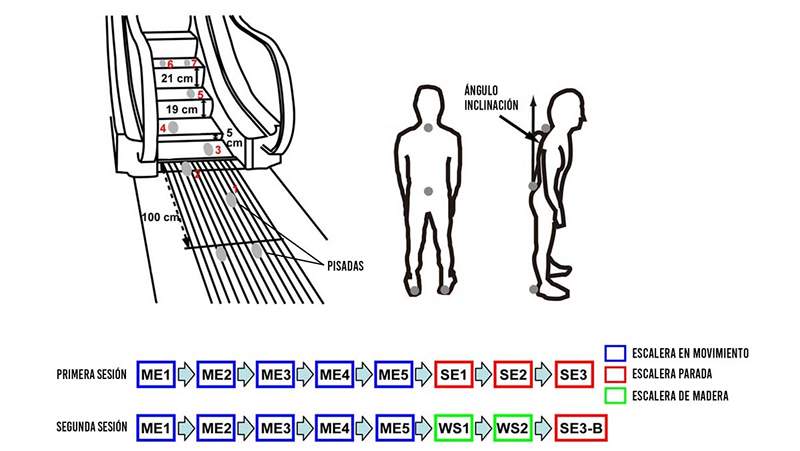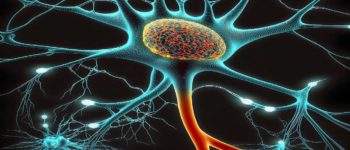Why we unbalance when climbing a mechanical staircase that we know is stopped

- 1212
- 349
- Charles Fay
Who has not ever experienced the strange sensation of imbalance or balancing that occurs when accessing a mechanical staircase is stopped, this curious phenomenon is the central theme of a scientific study in which researchers set out to explore this phenomenon from a scientific perspective, raising several hypotheses about why it happens and how it relates to our consciousness and subconscious motor control. Through a series of carefully designed experiments, the study managed to reveal the mysteries of this aspect of our interaction with the physical world.
Content
Toggle- Let's start at the beginning
- The three theories that the researchers raised
- What was the experiment
- The fault is from the postural balancing forward
- Why the conscience cannot be overcome to the subconscious motor process
- The conclusions of the study
- Bibliography
Let's start at the beginning
When we climb a mechanical staircase for the first time, although we can see that it is in motion and that we prepare for it, our body is inevitably tilted back as a result of the speed of the staircase.
After several attempts, Our brain ends up getting used to that behavior and ends it properly compensating, So over time, the entrance to the mechanical staircase no longer produces a balancing back of our body, the brain has learned and we can climb without danger of unbalanced.
This knowledge becomes part of our muscle memory and like other behaviors learned, such as walking or riding a bicycle, we can put it into practice when we need it unconsciously, without thinking about it.
These automated movements are mainly controlled by the cerebellum that plays a crucial role in the coordination and control of the precise and learned movements, including the usual or automatic movements, and is also involved in motor learning, which means that it helps our brain to learn and remember how to perform specific movements.
In addition to the cerebellum, other areas of the brain are also involved in the control of automated movements, such as basal nodes, a group of structures at the base of the brain, which are involved in a variety of functions, including control of the movement, learning, memory and planning of actions.
Now, once we have this behavior internalized, it turns out that if we find a mechanical staircase that, either by breakdown, maintenance or other causes, is stopped and we access it, there is a slight sensation of imbalance fruit of our behavior learned. And this happens despite the fact that we are aware that the mechanical staircase is stopped and therefore our movements should be adapted as if we climb a conventional staircase, but this does not occur.
This behavior caught the attention of a group of five Japanese scientists: Takao Fukui, Toshitaka Kimura, Koji Kadota, Shinsuke Shimojo, Hiroaki Gomi who decided to study this phenomenon to discover the reason for this behavior.
The three theories that the researchers raised
The main objective of the study was to investigate and understand the phenomenon of the strange sensation that is experienced when climbing a mechanical staircase that is detained, and determining what causes this sensation and how it relates to our consciousness and subconscious motor control.
The researchers raised three possible explanations for the appearance of this sensation and designed a series of experiments to test which one was correct and thus identify the underlying mechanism of that strange sensation, and provide a new perspective on how our processes are coordinated and influenced conscious and subconscious in the performance of common motor tasks.
The three theories raised were these:
- The strange sensation occurs concurrent but independent of behavioral or postural properties. That is, the sensation has nothing to do with the body sensation derived from such behavioral properties, for example, the simple lack of familiarity with the situation of meeting a detained mechanical ladder could induce the sensation.
- The strange sensation occurs due to the unique height of the steps, in which the first step is shorter than the others. This unusual lack of uniformity of the steps can induce clumsiness because we are not accustomed to such irregularity, and awkwardness leads to the strange sensation.
- The strange sensation results from an inconsistent inappropriate action with the current situation despite the correct understanding of the situation. Uploading to a mechanical staircase is a highly accustomed action, so the usual motor program for a moving ladder would even when we climb to a stopped ladder, therefore this subconscious appearance of the specific common motor program of the staircase leads to the inappropriate motor behavior, which leads to strange sensation.
The researchers designed a wooden ladder to imitate the physical dimensions of a detained mechanical staircase, this staircase had the same height of steps as a detained mechanical staircase, and the height of the first step was also the same as that of the mechanical staircase.
The purpose of using the wooden staircase in the experiment was to rule out the possibility that the strange sensation that people experience when climbing a mechanical staircase was due to the irregular height of the steps, if this were the case, then the participants They should experience the same feeling when climbing the wooden ladder.
 Episodic memory, what is it
Episodic memory, what is it What was the experiment
The experiment was carried out along two sessions, each of which included 16 blocks of eight consecutive trials in which the participants alternated mechanical stairs, mechanical stairs stop and the wooden ladder that imitated the irregular disposition of The steps on the Mechanical Staircase Parada.
In the first session, five consecutive tests were carried out on a movement in motion followed by three consecutive tests on a detained mechanical ladder, while in the second session, the participants carried out five tests on a mechanical staircase in motion, two tests on the wooden stairs that imitated the physical dimensions of a detained mechanical ladder, and finally an test on a mechanical staircase stop.
During the tests, information was collected from the cinematic properties of the lower extremities and the body When climbing the detainee staircase, the mechanical staircase and the wooden stairs, and also analyzed the subjective sensation of the participants after the tests on the detained mechanical staircase and the wooden stairs.
The researchers observed that Study participants showed inappropriate motor behavior by accessing a detained mechanical ladder, In particular, they noticed a forward postural balancing that was similar to the behavior that the participants showed when climbing a mechanical staircase in motion.
This postural balancing forward is an adaptation that is normally carried out when climbing a mechanical staircase in motion to counteract the ascending acceleration, however, this behavior is unnecessary and, therefore, counterproductive when climbing a mechanical staircase stopped.
In addition, it was found that This inappropriate motor behavior occurred despite the fact that the participants were fully aware that the mechanical staircase was stopped, which suggests that it is the result of a motor program that is activated automatically, even when it is not appropriate for the current situation.
The measurements made in the three scenarios showed significant differences in the position and speed of the participants. When the participants uploaded the wooden stairs that imitated the dimensions of a detained mechanical ladder, they did not show the forward postural balancing that was observed on the mechanical staircase and also, the speed of the support leg and the leg in the air was lower compared to the mechanical staircase.
On the other hand, when climbing a mechanical staircase, the participants showed a postural balancing forward, similar to the behavior they showed when climbing a mechanical staircase in motion, however, the speed of the support leg and the leg in the Aire was lower compared to the mechanical staircase in motion, demonstrating that the participants were able to anticipate (partially) the new situation.
Finally, when climbing a movement in motion, the participants showed a postural balancing forward and a higher speed of the support leg and the leg in the air compared to the other two scenarios.
These results suggest that The usual motor program to climb to a movement in motion is automatically activated when climbing a mechanical staircase that is stopped, which causes inappropriate motor behaviors. Interestingly, this motor program is not activated when climbing the wooden stairs even though they imitated the design of the mechanical stairs, indicating that the sensation is not due to the irregular height of the steps.

Muscle memory, the "energy savings" mode of our body and our mind
The fault is from the postural balancing forward
The researchers made several measurements to evaluate the position and speed of the participants during the experiment, on the one hand, they measured the angle of the trunk of the participants in relation to the vertical to evaluate their position when climbing the mechanical staircase or the stairs of wood. This angle allowed to verify if the participants leaned forward, which is a usual motor behavior when climbing a mechanical staircase in motion.
The researchers also measured the speed of the support leg during contact with the ground, which allowed to know if the participants are trying to move faster when the staircase stopped (as they would climb to a mechanical staircase in motion), And finally, they measured the speed of the leg in the air which would allow to check if the participants are trying to move faster, as they would climb to a mechanical staircase in motion.
These measurements allowed researchers to evaluate whether participants showed inappropriate motor behaviors, such as postural balancing forward and an increase in speed, climbing a mechanical staircase stopped.
The forward postural balancing is a habitual motor behavior that we normally perform when climbing a mechanical staircase in motion, since this balancing forward helps us to counteract the ascending acceleration of the mechanical staircase and maintain our balance.
However, when we climb a detained mechanical ladder, this forward postural balancing is unnecessary and, Although we are aware that the ladder is stopped, our usual motor program is automatically activated, which leads us to bow forward as if the ladder were moving.
This inappropriate motor behavior is what causes that feeling of imbalance or instability that contributes to the strange sensation we experience when climbing a detained mechanical staircase. In addition, the fact that this behavior occurs despite our awareness that the ladder is stopped can further increase the feeling of strangeness.
In the context of this study, our brain anticipates that the mechanical staircase will move (based on past experiences), but when the ladder is stopped, this prediction is betrayed, and there is a discrepancy between what our brain anticipates that it will happen and that really happens, which causes the feeling of imbalance.
This conflict is related to the recent motor control theory focused on internal models, which suggests that Our brain uses internal models to predict and control our movements. An internal model is a mental representation of how our body works and how it interacts with the world., So when we perform an action, our brain uses this internal model to predict the result of the action; If the real result differs from the prediction, this generates the feeling of imbalance.
This conflict is also related to the difficulty in attributing our inappropriate motor behavior to exogenous and endogenous events. Exogenous events are those that occur outside us, as the mechanical staircase stops, while Endogenous events are those that occur within us, as our usual motor program that is automatically activated. When our inappropriate motor behavior is the result of a conflict between these exogenous and endogenous events, it can be difficult to determine the exact cause of the strange sensation.
Interestingly, the perception of the sensation decreased after several consecutive tests of access to a detained mechanical ladder, the participants reported a stronger sensation during the first trial on a mechanical staircase stopped immediately after climbing a mechanical staircase in motion, however , this sensation decreased in successive tests on the detained mechanical staircase although it did not disappear completely.
This suggests that the usual motor program to climb a mechanical staircase in motion can be adjusted with the repetition of the task on a detained mechanical staircase, in other words, it seems that our subconscious motor control can adapt to the new situation with the practice with the practice , which reduces the appearance of inappropriate motor behaviors and, therefore, the strange sensation.
Why the conscience cannot be overcome to the subconscious motor process
The subconscious consciousness and control are two different brain processes that often work together but can also operate independently. Subconscious motor control refers to the motor actions that we automatically perform without consciously thinking about them, how to walk, speak or climb stairs; These actions are controlled in parts of the brain that do not require our conscious attention.
Consciousness, on the other hand, refers to our ability to be aware of our actions and make deliberate decisions, And although our consciousness can influence our subconscious motor control, it cannot control it completely, this is because many of our motor actions are so common that they are automatically performed without the need for conscious thinking.
In the case of climbing a mechanical staircase, although we are aware that the staircase does not move, our usual motor program to climb to a movement in motion is automatically activated, and this program is so strong that our consciousness cannot dissipate it completely.
This separation between consciousness and subconscious motor control can be useful in many situations, since it allows us usual actions are not appropriate, such as climbing a mechanical ladder that is stopped.
 How the nerve impulse is transmitted
How the nerve impulse is transmitted The conclusions of the study
The study concluded that The feeling of imbalance that is experienced when climbing a mechanical staircase is the result of a conflict between consciousness and subconscious motor control, And although we are fully aware that the mechanical ladder does not move, our usual motor program, which is accustomed to climbing in motion, automatically activates which causes inappropriate motor behaviors, such as a postural balancing forward, which produces The feeling of imbalance.
It was shown that this sensation is not due to the irregular height of the steps of a detained mechanical ladder, since in experiments in which the participants climbed wood stairs with the same height of steps as a mechanical staircase stopped, the participants did not report of the same feeling.
The study also suggests that this phenomenon can be a useful example to explore the relationship between subconscious consciousness and control that could provide a new perspective on how our conscious and subconscious processes are coordinated and mutually influenced in the performance of motor tasks usual.
The differences between the human brain and artificial intelligence
Bibliography
- ODD SENSATION INDUCED BY MOVING -PHANTOM WHICH TRIGGERS SUBCONSCIOUS MOTOR PROGRAM - https: // doi.org/10.1371/Journal.places.0005782
- Macrovector image in Freepik - https: // www.Freepik.is/vector-grays/building-disease-composition-plana_4342592.htm
- « The Vandenbergh effect the puberty changes when females live with males
- Structural family therapy, what is it »

